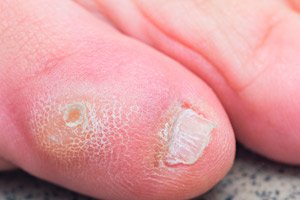
All iLive content is medically reviewed or fact checked to ensure as much factual accuracy as possible.
We have strict sourcing guidelines and only link to reputable media sites, academic research institutions and, whenever possible, medically peer reviewed studies. Note that the numbers in parentheses ([1], [2], etc.) are clickable links to these studies.
If you feel that any of our content is inaccurate, out-of-date, or otherwise questionable, please select it and press Ctrl + Enter.
Painful callus
Medical expert of the article
Last reviewed: 04.07.2025

A painful callus is most often wet (moist) - with the formation of a blister in the area of excess pressure or friction of the skin, but dry calluses, primarily core calluses, can also cause pain when walking. [ 1 ]
Causes painful callus
The main reasons are discussed in the publications:
- Corns and calluses
- Callus on the heel
- Dry calluses on feet with and without core
- Core callus: causes, structure, treatment
- A dry callus hurts: what are the causes and what to do?
- Bloody callus on feet and hands
Their symptoms are also described there.
Risk factors
Any callus can become painful, and a painful callus on the toe, little finger most often appears due to unsuitable shoes (primarily too narrow and with high heels). Many people get calluses due to increased sweating of the feet.
In addition, risk factors for excessive pressure and/or friction of the skin with the formation of thickening or pustules on the skin include problems with the feet, each of which consists of 26 bones, 33 joints, 107 ligaments and 19 muscles with many tendons. This includes a low arch of the foot (flat feet), and deviation of the foot outward with its hallux valgus, and limited mobility of the first joints of the big toes (with the formation of calluses under and above them).
It should be borne in mind that excess body weight, which puts too much stress on the feet, can also disrupt their biomechanics, increasing the risk of painful calluses on the feet.
Pathogenesis
The mechanism of development of painful sensations in the presence of a callus is the same as the pathogenesis of the occurrence of any pain.
It is caused by irritation of nociceptors – pain receptors, that is, free nerve endings of the skin – and the transmission of nerve impulses to the spinal cord (along the spinal axons of the anterolateral system), and then to the central nervous system – to the somatosensory fields of the cerebral cortex.
Complications and consequences
Podiatrists include among the complications and consequences of painful calluses both discomfort when walking and changes in gait (with the appearance of limping) - with a potential negative impact on the entire musculoskeletal system, but also the development of inflammation of the skin and subcutaneous tissue of bacterial origin.
Such inflammation can cause a purulent-necrotic process in the periosteum of the underlying bone structures – periostitis.
Diagnostics painful callus
A painful callus is diagnosed based on the patient's complaints by visual examination; in the case of a core callus, a dermatoscope can be used.
Differential diagnosis
Differential diagnosis includes plantar warts, palmoplantar hyperkeratosis, keratoderma, bullous dermatitis.
Who to contact?
Treatment painful callus
How the treatment is carried out [ 2 ] is described in detail in the publications:
Prevention
You can prevent the appearance of calluses by wearing suitable shoes, taking care of your feet and combating their sweating. Read more:
Forecast
In terms of healing, a painful callus has a favorable prognosis.

